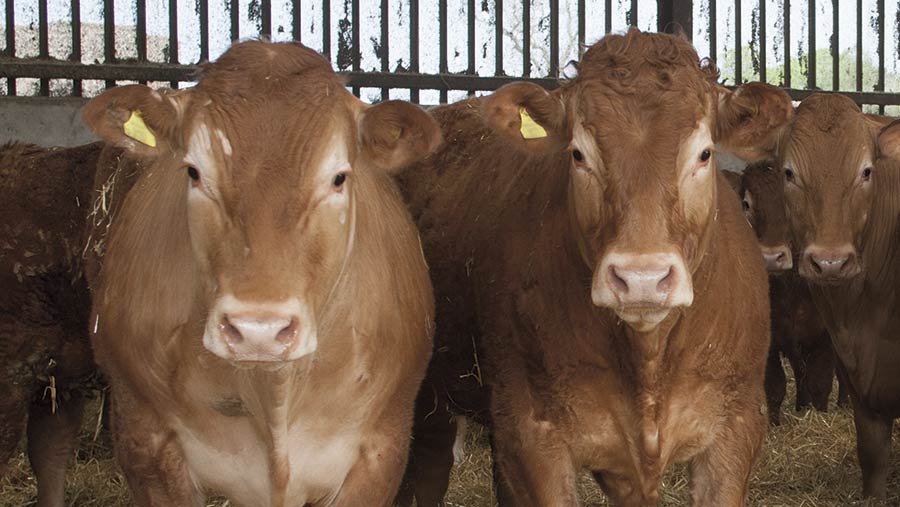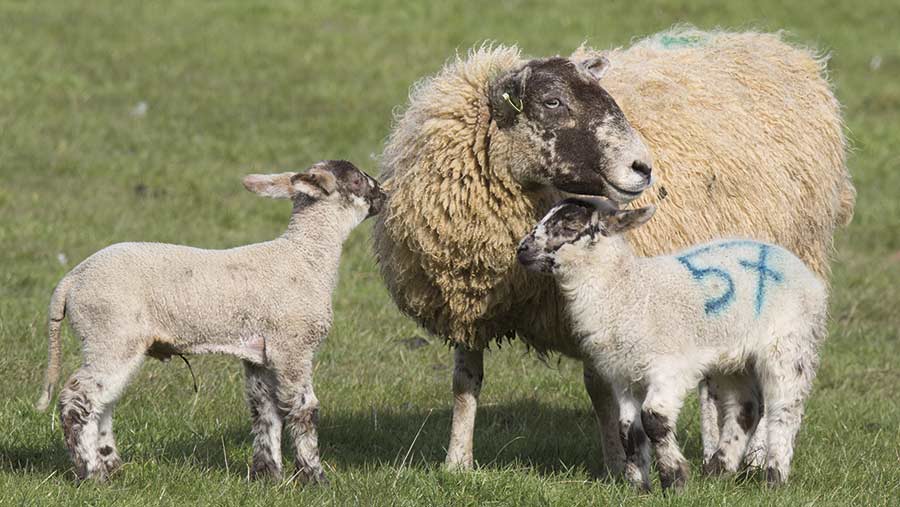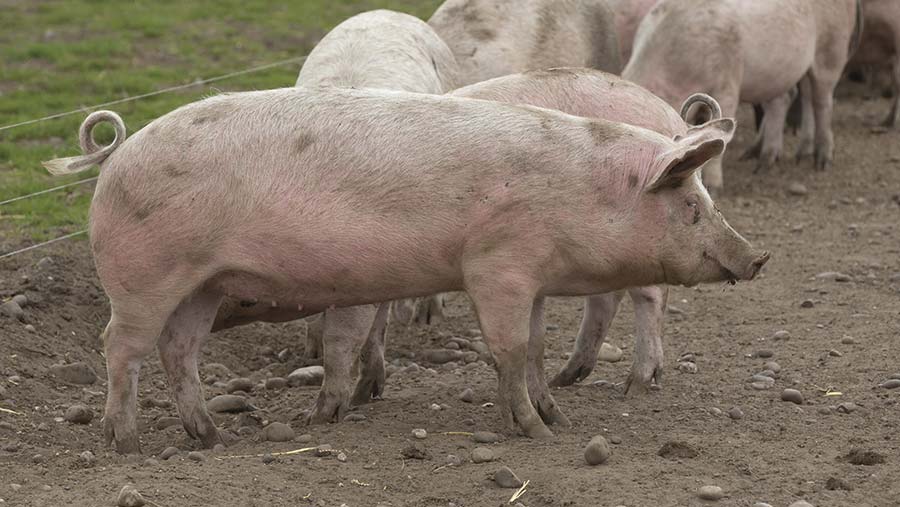Outlook: Beef, sheepmeat and pork markets in 2017
There are some positive indications for beef, sheepmeat and pig markets this year.
However, currency will as ever play a huge part in determining farmgate prices and many beef and sheep producers have yet to return to profitability.
Imports will be a challenge for all species, as will persuading cash conscious consumers to keep buying beef, lamb and pork.
AHDB recently presented a webinar outlook for all three sectors, summarised here. The full presentation with slides and audio is available on the AHDB website.
See also: Compared – nine supermarkets’ commitment to British lamb
Beef
Debbie Butcher, senior analyst, AHDB beef and lamb

© Tim Scrivener
Market background
2016 saw robust prices over summer but then stability at lower than five-year average levels.
Exports rose 10% in volume and 5% in value, to £328m.
Imports from Ireland fell by about 5,000t to 44,400t in the three months following the referendum.
Beef sales did well in January, up 6% but retail prices are lower, driven by the roasting sector.
Cow weights have also fallen to their lowest since cow beef came back into food supply.
Dairy herd size is falling – dairy-bred calf registrations had been trending up until late 2015, since then dairy females are down 25,000 and male dairy calf registrations are down 31,000.
Stable suckler herd – registrations are 33,000 head up for heifer calves and 34,000 up for bulls over roughly the same time period as for dairy figures.
Outlook
This year’s market holds a more optimistic price outlook than at this time last year – overall supplies will be tighter.
Beef cow numbers are forecast to fall 8% to 615,000 head.
Prime beef cattle supply is forecast to rise 1% this year to 1.99 million head but production is forecast down 2% to 890,000t.
The trend to lower carcass weights in steers, heifers and young bulls will limit production growth.
It’s a positive outlook for exports, which are also increasingly of higher value as the proportion accounted for by boneless beef is now more than 71% compared with 46% less than six years ago.
In the mix are about 20,000 more native cattle aged 12-24 months in the UK – we continue to see more of those in the mix so the premium may not quite be as great as it has been in previous years.
Irish output set to rise by 100,000 head on 2016, to 1.7 million head – the highest in 10 years and so higher imports from Ireland are likely this year.
However, inflationary pressure on consumers likely to affect higher-priced meats such as beef – with food prices rising, beef is still very vulnerable in context of modern lifestyles.
Sheepmeat
Mark Kozlowski – senior analyst, AHDB beef and sheep

© Tim Scrivener
Market background
The 2016 lamb price pattern was flat, not a normal pattern, then towards the end of year rose to record levels for the time of year.
Supplies in 2016 were tighter than in the previous year – the first seven months of the season saw 121,000 fewer lambs slaughtered because poor pasture meant lambs were slow to finish.
Imports were overall lower than in 2015 – higher in the first half of the year but then the referendum result and consequent weakening of pound made imports less attractive. New Zealand produce had a big commercial advantage in price until the pound fell from mid-2016.
NZ remains our largest supplier but volumes from Australia were also down in first 11 months of 2016.
At domestic retail level, it was a poor year for lamb in 2016, with sales falling because of (relatively high) retail prices compared with competing proteins, especially chicken and pork.
Slaughtering of home produced lamb is down so far in the season, compared with 2015-16, although was higher in October and November.
Those that were sent for slaughter were at lower weights so production was down too – by 11,300t compared with 2015 to 290,300t.
However adult sheep slaughterings rose by 6% in 2016, with 1.7 million head killed in the year.
Despite tighter supplies for the time being, lamb prices have fallen below year earlier levels.
Currency has had a massive effect on trade – official figures show exports falling 1% but AHDB has doubts over the accuracy of data and thinks exports may have been considerably higher than the 78,600t which HMRC recorded.
High autumn finished lamb prices pushed store lamb higher so more were sold as stores and are waiting to come to market in the first half of 2017.
Outlook
France is still our main market but lamb consumption in France is falling and the French favour their own home-produced lamb.
In addition, like the UK, France carried more lambs through into the New Year. Our exports to France this year will probably be level with 2016.
There’s a more positive outlook for shipments to Germany, to which exports rose 14% in 2016.
This country’s large number of immigrants are almost all sheepmeat eaters and this has helped, with a further possible increase in exports to Germany and Scandinavia this year.
As with beef, there is a drive to ship more lamb as cuts rather than carcasses to return more to processors and producers – 23% in 2010, 34% in 2016 (January-November).
The value of the pound and higher UK production will mean imports will fall and exports may rise marginally this year.
While there was small growth in the 2016 breeding flock, a lower lambing percentage will lead to a smaller lamb crop in 2017.
However a slight rise in supply is possible if spring and early summer growing conditions follow a more normal pattern, so there could be pressure on prices.
Pigmeat
Vikki Campbell, data and analysis manager, AHDB Pork

© Tim Scrivener
Market background
Pig prices started 2016 in real terms at their lowest since February 2000 and ended the year 40p higher than at their lowest point (March) – producers were back in profit.
There was strong EU price growth from late spring last year – production levels rose in the first half of 2016 but fell in the second six months.
Both imports to and exports from the UK were up, driven primarily driven by fresh and frozen pork. Imports from Denmark surged, up 72% on a year earlier, although there are queries being raised over whether this figure is inflated as the data goes against the trend implied by prices.
UK exports rose but not by as much as was expected, possibly hampered by tight supply and better domestic prices.
Processed pigmeat retail sales at home picked up slightly in the 12 weeks to 4 January this year, while fresh and frozen pork sales were down.
EU production levels also tailed back, while exports rose, with China the catalyst for this growth so that buy the end of 2016 more than two thirds of Chinese imports were from the EU.
Outlook
EU production is expected to fall in first half of 2017, then recover.
Global pig production is also expected to return to growth in 2017, with expansion in the US, Brazil and Russia but there is some doubt over China as very strict environmental controls will limit large scale expansion there.
In the UK, Defra stats show a rise in the UK sow herd but AHDB takes a drop in breeding pig feed production, among other factors, as evidence for a declining herd.
Using AHDB’s assumed figures, slaughterings are forecast to fall in the first half of 2017, with recovery in the second half of the year.
Carcass weights are due to remain stable, while production is forecast to fall in line with slaughtering levels, which could support prices moving further into 2017.
Overall, there will be less pork on the UK market in 2017, with only a small increase in production and higher input costs possibly limiting weight gain.
Imports are likely to reduce – a lower pound makes UK pork more competitive at home and abroad, while, tighter supply on the continent may limit the availability of pork to import.
In turn, a weak pound should help to boost UK exports this year but trade could be capped by tightening supply.
With less pork available in 2017, this is expected to support prices at least in the first half of the year, however if input prices continue to rise, this will hit profitability.
The market should firm for some months to come, with EU supply tightening too. Chinese demand is set to continue but increased production from other global competitors could have an impact on our trade and prices.
